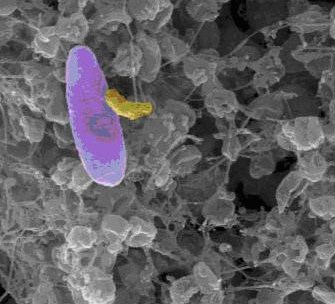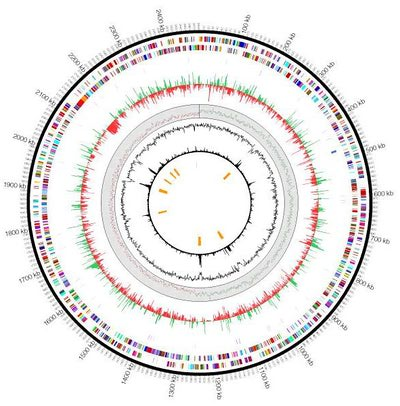Micavibrio: Difference between revisions
| Line 35: | Line 35: | ||
==Pathology== | ==Pathology== | ||
==References== | ==References== | ||
Revision as of 14:26, 3 May 2012
{Uncurated}} A Microbial Biorealm page on the genus Micavibrio
Classification
Higher order taxa
Bacteria; Proteobacteria; Deltaproteobacteria; Bdellovibrionales; Bdellovibrionaceae; Micavibrio
Species

M. aeruginosavorus, M. admirandus
Description and significance
Micavibrio aeruginosavorus is a predatory bacteria which displays ‘vampire-like’ behavior in an obligatory parasitic lifestyle on other bacteria. Gram-negative micro-organisms known to be pathogenic in humans, such as Pseudomonas aeruginosa, are the prey for this host specific predator. The life cycle of M. aeruginosavorus' is characterized by an attack phase and an attachment phase.4 The attack phase consists of motile M. aeruginosavorus which seek their prey.4 The attachment phase consists of M. aeruginosavorus attaching to the cell surface of the bacterial prey.4 M. aeruginosavorus will then feed on the prey bacteria and divide via binary fission in the process until all the nutrients have been depleted leaving the prey bacteria dead.4 M. aeruginosavorus are host specific towards pathogenic bacteria (some of which being multidrug-resistant) known to cause infection in humans.1 Researchers are focusing on the predatory capabilities and interactions of M. aeruginosavorus for its potential use as a 'live antibiotic' for pathogenic bacteria associated with human infection.1
Genome structure

The genome of M. aeruginosavorus ARL-13 has been completely sequenced and is a single circular molecule consisting of 2,481,983 bp and a 54.7% G+C content.4 It is predicted that 90.3% of the genome codes for 1 rRNA operon, 40 tRNA genes and 2,434 open reading frames (ORFs). 4 There were no extragenomic DNA molecules (phage or plasmid) identified from the sequence and there was a complete absence of mobile genetic elements including insertion sequences, transposons and retrotransposons.4 Numerous genes are encoded which have an important role in predator-prey interaction, for example, hemolysin-related proteins.4 RNA-Seq analysis has shown a substantial difference in transcriptome between the attack phase (seeking prey) and attachment phase (feeding on prey and replicating). 4 M. aeruginosavorus encodes six hemolysin related proteins belonging to the RTX family of toxins which are suggested to contribute to recognizing and adhering to prey.4 The genome of M. aeruginosavorus is a moderate size at 2.4 Mbp and is almost twice the size of most obligatory intracellular alphaproteobacteria and is smaller, by comparison, to most free living alphaproteobacteria.4 The genome also encodes a large selection of hydrolytic enzymes with 4.3% of the genome predicting to encode 49 peptidases and proteases, 12 lipases, 4 RNAses, 2 DNAses and 37 additional hydrolases.4
Cell and colony structure
M aeruginosavorus was first isolated in wastewater. M. aeruginosavorus are small in size (0.5 to 1.5 μm long), curved, rod shaped, with a single polar flagellum.2 Replication is via binary fission which produces one daughter cell at a time. M. aeruginosavorus will form plaques in diluted nutrient broth agar.4
Metabolism
Although M. aeruginosavorus depends on prey for replication, the genome encodes for most of the major metabolic pathways.4 Analysis of the genome suggests there are numerous amino acids that M. aeruginosavorus can neither make nor assimilate directly from the environment, which explains the prey dependency.4 Genome analysis also show many free-living bacterium features such as genes involved in lipopolysaccharide and cell wall biosynthesis, glycolysis, TCA cycle, electron transport chain, ATP synthase (indication of ATP generation) and respiration systems.4 It also contains a pentose phosphate pathway and a full set of genes for the metabolism of nucleotides.4 While M. aeruginosavorus encodes the genes for the synthesis of 13 amino acids necessary for protein synthesis, it is missing the biosynthesis pathways for the remaining 7 amino acids (Alanine, Arginine, Histidine, Isoleucine, Methionine, Tryptophan and Valine).4 The genome is also missing transporters for amino acids, peptides and amines, which M. aeruginosavorus obtains from its prey.4
Ecology
Experiments show optimal conditions under which M. aeruginosavorus was able to prey were temperatures ranging from 25 to 37ºC with an aerobic environment and unable to prey under anaerobic conditions.1
Pathology
References
1 Dashiff, A., Junka, R., Libera, M. and Kadouri, D. (2011), Predation of human pathogens by the predatory bacteria Micavibrio aeruginosavorus and Bdellovibrio bacteriovorus. Journal of Applied Microbiology, 110: 431–444. doi: 10.1111/j.1365-2672.2010.04900.x
2 Dashiff, A., Keeling, T., & Kadouri, D. (2011). Inhibition of predation by Bdellovibrio bacteriovorus and Micavibrio aeruginosavorus via host cell metabolic activity in the presence of carbohydrates. Applied & Environmental Microbiology, 77(7), 2224-2231. doi: 10.1128/.02565-10
3. Kadouri, Daniel, Nel C. Venzon, and George A. O’Toole. Vulnerability of Pathogenic Biofilms to Micavibrio aeruginosavorus. Applied and Environmental Microbiology. 73.2 (2007): 605-14. doi:10.1128/AEM.01893-06
4 Wang, Z.; Kadouri, D. E.; Wu, M. (2011). "Genomic insights into an obligate epibiotic bacterial predator: Micavibrio aeruginosavorus ARL-13". BMC Genomics 12: 453. doi:10.1186/1471-2164-12-453
Edited by Kelly Gordon and Jennifer Willis, students of Dr. Lisa R. Moore, University of Southern Maine, Department of Biological Sciences, http://www.usm.maine.edu/bio
